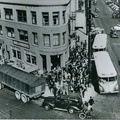Read Part 5 >>
PLANTATION STRIKE OF 1920
After the 1909 Strike, the workers’ wages stagnated at the same level while the cost living continued to rise. By the end of World War 1, the monthly cost of living had risen by as much as 45 percent.1 Proposals were sent to the HSPA asking for higher wages, nurseries for children of workers and changes in the bonus system, but their demands were summarily rejected.
By 1919, labor organizations had formed on Maui, Kauai, Hawaii, and Oahu. These groups sent 58 delegates to Honolulu where they established the Japanese Federation of Labor,2 the official voice of the plantation workers.
In the 1909 Strike, Japanese plantation workers composed 70 percent of the labor force. By 1919 they were reduced to 55 percent and the Filipinos had increased to 23 percent. The dissatisfied plantation workers formed the Filipino Labor Union-Hawaii led by Pablo Manlapit.
On December 6, both the Japanese Federation of Labor and the Filipino Labor Union submitted separate but similar request to the HSPA: a daily wage increase from 77 cents per day to $1.25 for men and $.95 for women; an 8-hour work day; improved bonus conditions; double pay for overtime; paid maternity leave; a greater share of the profits paid to contract cane growers, and improved health and recreation provisions.
“People know Hawaii as the paradise of the Pacific and as a sugar producing country,” the Japanese Federation of Labor stated. “But do they know that there are thousands of laborers who are suffering under the heat of the equatorial sun, in field and in factory, and who are weeping with ten hours of hard labor and with a scanty pay of 77 cents a day?”3
The Filipino Labor Union struck first. On January 19, 1920, 3,000 Filipino workers from five plantations on Oahu walked off their jobs.4 Manlapit appealed to the Japanese Federation of Labor:
This is the opportunity that the Japanese should grasp, to show that they are in harmony with and willing to cooperate with other nationalities of this territory, concerning the principles of organized labor…We should work on the strike shoulder to shoulder. 5
The Japanese language press called for united action and support for their Filipino comrades. The Hawaii Hochi called for “action together.” The Hawaii Shimpo stated “Their problem is your problem” and the Hawaii Choho declared “no barriers of nationality, race, or color” between the Japanese and Filipinos.
On February 1, the Japanese joined the strike, walking out at Aiea, Waialua, Waipahu, Ewa, Waimanalo, and Kahuku plantations in Oahu. Before the end if the month 5,300 Japanese and 2,800 Filipinos went on strike. Together they comprised 77 percent of the entire plantation work force in Oahu.
“Should Hawaii be controlled by Americans or should it be controlled by aliens?” the English dailies exhorted. The Honolulu Star Bulletin and the Pacific Commercial Advertiser immediately accused the Japanese of a conspiracy to take “alien” control and “Japanize” the islands.
Over 12,000 Filipinos and Japanese workers and their families were evicted from their plantation-owned houses, given 48 hours to return to work or leave. The majority sought temporary refuge in Honolulu.
As the strike dragged on, the resolve of the strikers weakened the strikebreakers and new Filipino workers were imported to replace the strikers. The bitter six-month strike drew to a close on June 30 with the planters refusing any change. The strike had cost the planters $12,000,000 and the Japanese community at least $200,000.
Again the planters claimed victory. But three months later they increased wages by 50 percent, allowed workers to collect their bonuses on a month-to-month basis, and increased their social welfare and recreational activities on the plantations.
The Federation leaders and others in the labor movement recognized the need to build a non-racial labor organization with “laborers of all nationalities” if they were to win their future battles. Two decades later, the International Longshoremen’s and Warehousemen’s Union (ILWU) rallied the support off all plantation workers under the slogan: “An injury to One is and Injury to All.” On November 18, 1946, a 79-day, territory-wide sugar strike ended with workers receiving a higher wage increase than they had originally demanded. For the first time Hawaii’s working class could claim a clear victory over the plantation owners.
Notes:
1. In Roland Kotani, The Japanese in Hawaii: A Century of Struggle, p. 34..
2. The organization’s name was changed to the Hawaii Japanese Laborer’s Association in April 1920.
3. Labor Problems in Hawaii, Hearings before the Committee on Immigration and Naturalization, House of Representatives, Serial 7-Part 2, 1921, pp. 827-282, in Ernest Wakukawa, A History of the Japanese People in Hawaii (Honolulu, 1938) p. 241.
4. The five plantations included Aiea, Waipahu, Ewa, Waialua, and Kahuku.
5. In Roland Kotani, The Japanese in Hawaii: A Century of Struggle, p.48.
* Issei Pioneers: Hawai‘i and the Mainland, 1885-1924 is the catalogue accompanying the National Museum’s inaugural exhibition. Using artifacts from the National Museum’s collection to tell the story of the courageous “Issei Pioneers,” the catalogue focuses on the early immigration and settlement years. To order the catalogue >>
© 1992 Japanese American National Museum





